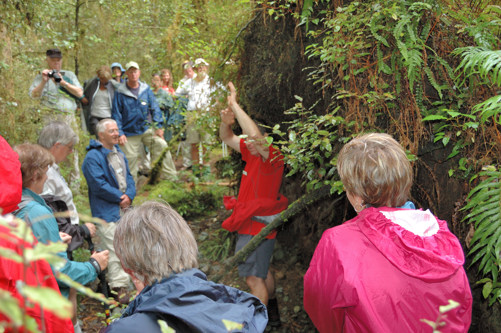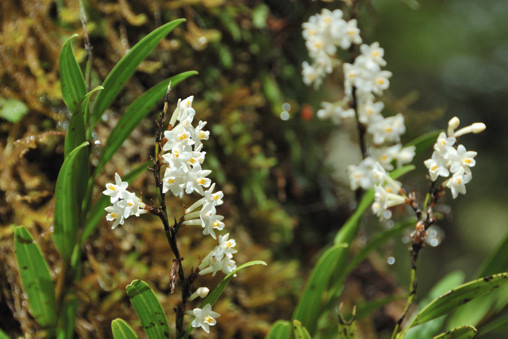Most of the first day of our trip was spent getting from Queenstown to the starting point of the hike in southwest or Fjordland section of the South Island. After meeting the rest of the group and three of our four guides – Kevin, the head guide, Amy, and Nabu – we boarded a bus for a three hour drive to the town of Te Anu, which is located on a large lake of the same name. After lunch there, we met up with the bus carrying the group who had just finished the track that was carrying our fourth guide, Jess. With everyone now assembled, our bus continued 30 minutes more up the lake to where we boarded a small lake ferry that took us to the starting point for the hike at the mouth of the Clinton River.
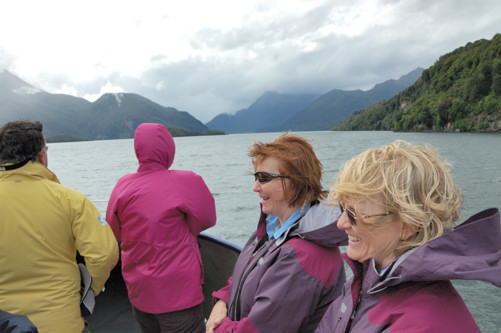 The forecast for the afternoon called for very heavy rain starting in the afternoon and continuing into the night. Although there was some rain during our bus ride and later overnight, and mountains were often shrouded in clouds on the this boat ride and our hike later, the most that we encountered was drizzle.
The forecast for the afternoon called for very heavy rain starting in the afternoon and continuing into the night. Although there was some rain during our bus ride and later overnight, and mountains were often shrouded in clouds on the this boat ride and our hike later, the most that we encountered was drizzle.
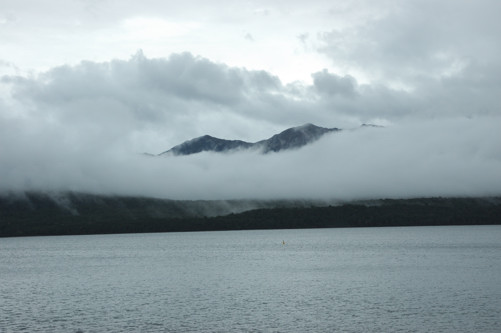 However, deeper into the park, especially on the other side of the Milford track, the predicted heavy rains did fall. Because these mountains do not hold much water, this rainfall raised the water levels in the watersheds of the Clinton and the Arthur Rivers dramatically, so the walkers further along on the track were walking in water that was sometimes up to their thighs.
However, deeper into the park, especially on the other side of the Milford track, the predicted heavy rains did fall. Because these mountains do not hold much water, this rainfall raised the water levels in the watersheds of the Clinton and the Arthur Rivers dramatically, so the walkers further along on the track were walking in water that was sometimes up to their thighs.
Our first day of hiking was really only a warm up: one mile long on what you can see in the photo on the left below is an easy-to-walk path. At the end of this path was Glade House, shown in photo below on the right.
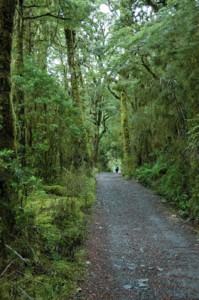
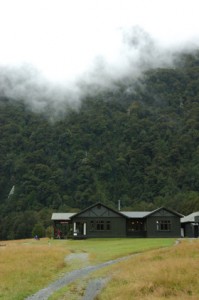
I believe I might have said something in an earlier email about how we were heading into the wilderness. That was technically true, but we certainly were not roughing it. 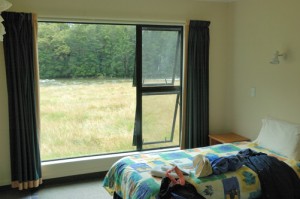 This shows the interior of our room at Glade House and the view from it. For this and each subsequent night, our room had a bathroom with a hot shower, electricity until the generator was turned off at 10 PM, and there were great hot meals for dinner – this is a far cry from traditional hiking. Sharing the track with us are “independent” hikers (we are “guided” hikers). They stay in a system of huts run by the NZ Department of Conservation (DOC) – to minimize impact on the track, tent camping is not allowed. These huts provide dormitory-style bunk rooms, toilets, water, and hot plates to cook on. However, there are no hot showers for the independents and they must pack in all of their food and cooking utensils. The DOC manages and maintains tracks for 9 “great walks” like the Milford track and probably hundreds of lesser tracks. These tracks have the great advantage that they can be done relatively cheaply, so that families in NZ do a lot of tramping. This is all wonderful, but we are certainly going to appreciate the creature comforts of our guided hike.
This shows the interior of our room at Glade House and the view from it. For this and each subsequent night, our room had a bathroom with a hot shower, electricity until the generator was turned off at 10 PM, and there were great hot meals for dinner – this is a far cry from traditional hiking. Sharing the track with us are “independent” hikers (we are “guided” hikers). They stay in a system of huts run by the NZ Department of Conservation (DOC) – to minimize impact on the track, tent camping is not allowed. These huts provide dormitory-style bunk rooms, toilets, water, and hot plates to cook on. However, there are no hot showers for the independents and they must pack in all of their food and cooking utensils. The DOC manages and maintains tracks for 9 “great walks” like the Milford track and probably hundreds of lesser tracks. These tracks have the great advantage that they can be done relatively cheaply, so that families in NZ do a lot of tramping. This is all wonderful, but we are certainly going to appreciate the creature comforts of our guided hike.
After arriving at Glade House, the guides took us out on a nature walk that provided a fairly intensive introduction to the flora and fauna of the Milford Sound area – of course some of this kind of discussion happened on the regular hiking days, but with four guides and 44 hikers, we would often hike for long stretches without actually seeing our guides.
One thing we learned about was what had been the unique ecology of New Zealand, and how it has been decimated. The land mass that makes up New Zealand has been formed quite recently from sediment that eroded from, what was then the combined Australian-Asian landmass. New Zealand literally sits on the subduction zone at the boundary of the Australian and Pacific tectonic plates. The islands are being pushed up at a rapid rate – in some places as much at 10 mm per year – as the plates slide beneath one another. It was a sudden change in this movement that led to the disastrous earthquake that just hit Christchurch. It was only about 85 million years ago that this process separated New Zealand from rest of Australia; importantly, this was during the time of the dinosaurs and before the emergence of mammals.
Because there were no mammals on the New Zealand land mass when it separated, the birds there evolved in very different ways than they did in the rest of the world. Without mammal predators, many of these birds did not need flight to survive and so evolved to become flightless. The kea, kiwi, and weka are several examples that still exist today, but there used to be many more. When the first Maori arrived they brought rats with them. Because these rats had no natural predators, their numbers increased rapidly and they began to wreak havoc on the bird and other indigenous populations. Later, Captain Cook and the European settlers who followed introduced other mammals the destroyed habitat and provided more competition for the indigenous species. In particular, becuase the settlers were disturbed by the large rat populations, they decided to introduce a predator to control rats. Since the early farmers objected to foxes because they kill sheep, the settlers brought what they called stoats (and we would call weasels), a vicious killer that did help to control the rats but also decimated other natural populations. Today, New Zealand is now spending millions of dollars a year trying to control rats, stoats, and possums, in an effort to restore some of the wilderness to something more like its original state. Many of the original indigenous species are gone forever and the only places where many of the surviving species can be found are some of the islands off the coast that were too small to be visited by settlers.
There are two other things that we learned on this hike that I found particularly interesting. The two pictures below are of the same plant. You may have seen the smaller version, on the left, as a house or office plant. What is interesting is that when it grows tall, 20 feet or so, as on the right, it changes form into a plant with quite normal looking leaves. The two variants of this plant are so different, that it took biologists almost a century to realize that they were the same – also puzzling was that they could never find versions of the plant on the left with flowers or seeds.
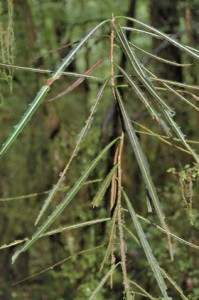
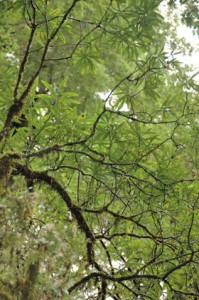
Once these two variants were recognized as the same plant, the question of course arose, why do they look so different and what triggers the change from the first form change into the second. It appears that the issue is survival. The juvenile form, on the left, has tough leaves, with little area so it cannot do much photosynthesis, and so grows very slowly. However, it is also apparently not very tasty, and so it was not attractive as food to the flightless birds that used to dominant this island. Even if this variant could only grow slowly, it could survive. Because it just barely got enough energy to survive, the younger form of the tree did not waste any energy producing flowers or seeds. However, once the plant got taller than the 15 or 20 feet, placing it out of the range of the flightless birds, the plant switched to its leafy form. The leaves and stems of this form of the tree turn out to be a preferred food for many of the flightless birds, but they were now too high to be eaten. With larger leaves, this form of the tree can grow rapidly and produces flowers and seeds.
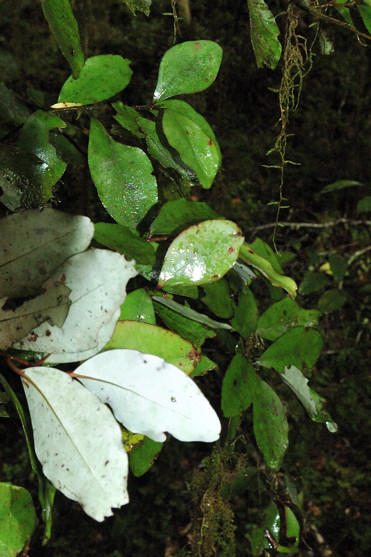 A second thing that fascinated me was what is sometimes called the New Zealand pepperwood tree, or mountain horopito (Pseudowintera colarata). Although the tree itself is not much to look at, the leaves are peppery with, to me, a strong taste of cloves. The Maori and the early settlers used these leaves both to flavor food and medicinally. One could, I imagine, use the leaves in cooking like bay leaves. This is something that I would very much like to try. Note also that, although the tops of these leaves are a normal green, the bottoms are bright white. This property made these leaves useful for marking paths.
A second thing that fascinated me was what is sometimes called the New Zealand pepperwood tree, or mountain horopito (Pseudowintera colarata). Although the tree itself is not much to look at, the leaves are peppery with, to me, a strong taste of cloves. The Maori and the early settlers used these leaves both to flavor food and medicinally. One could, I imagine, use the leaves in cooking like bay leaves. This is something that I would very much like to try. Note also that, although the tops of these leaves are a normal green, the bottoms are bright white. This property made these leaves useful for marking paths.
The photo below shows the group as Kevin makes a point about a fallen tree that is behind him.
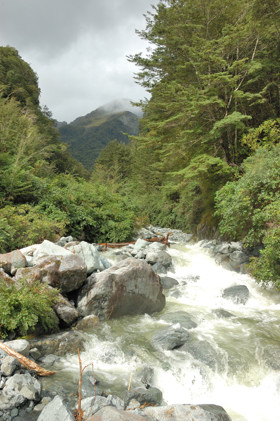 The endpoint of this walk was Glade Burn, the rapids in the photo on the right. The photo below shows a portion of our group, all doing different things, on the rocks that form the bank of Glade Burn.
The endpoint of this walk was Glade Burn, the rapids in the photo on the right. The photo below shows a portion of our group, all doing different things, on the rocks that form the bank of Glade Burn.
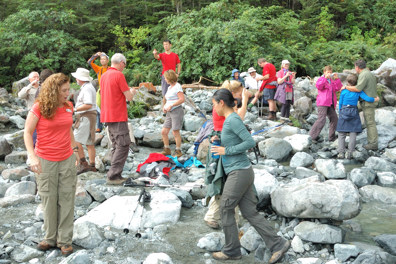
For a parting shot, I leave you with this orchid that was growing in a tree near Glade Burn.
